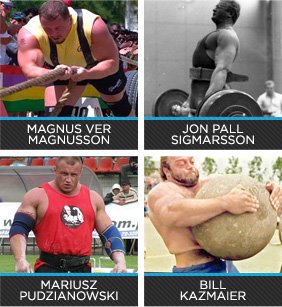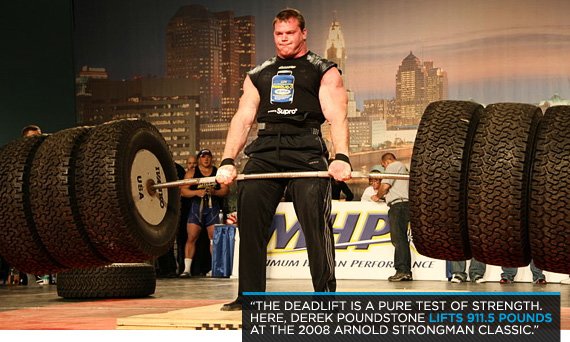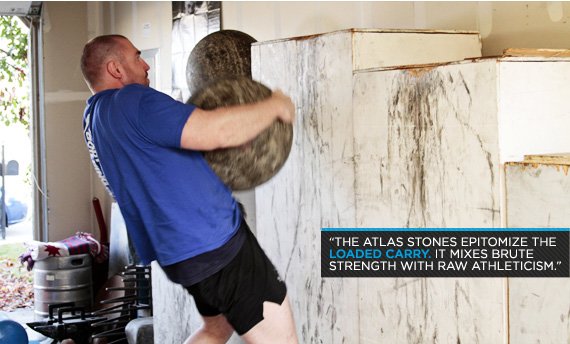The names just sound strong: Magnus ver Magnusson. Jon Pall Sigmarsson. Mariusz Pudzianowski. The immortal Bill Kazmaier. How many of us grew up watching these giants perform unfathomable strength feats, and knew right away that we wanted to be like them? To a child, it felt like watching the Hulk himself compete on ESPN.

So when we were old enough, we took that inspiration and hit the gym—squatting, benching, pulling, and getting bigger and stronger. Unfortunately, not many of us train in gyms that have the kind of equipment that strongman training necessitates. The truth is, if you want to be like a strongman, you need to train like a strongman.
Now, before you start pushing your car to Home Depot to buy cement to make your own Atlas stones, let's see what we can do with the weights you have access to currently. Strongman training requires you to develop a wide range of abilities, but they are best tackled in event-specific training. For the average gym rat, there may not be any competition on the horizon to prepare for, but you can still have fun while packing on muscle.
Gear Up To Get Strong
One of the beautiful things about strongman competitions is their simplicity. You don't need thousands of dollars of gear to be strong. You just need strength and something to lift.
With that said, there are a few simple tools that can help you make the most out of any weight room. If your gym has axles or fat bars in addition to Olympic bars, use them. If not, consider investing in a pair of thick grips like Grip4orce grips or Fat Gripz. They're relatively inexpensive and well worth the small investment.
If you do have access to specialized strongman equipment like a log or farmer's walk handles, by all means, use them wherever applicable in the program I outline below. Sandbags are also helpful in building the type of carrying strength and core stability required by strength competitions. A few hardy towels that can handle towel pull-ups are a must.

Strongman Training
While no two strongman contests are identical, variations of three events are almost always part of the program. All three are excellent indicators of the physical abilities that you want to develop if training like a strongman is your goal. Let's take a look at the core of strongman training.
Event 1 /// Deadlift
Whether your goal is to be a strongman or simply a strong man, grow acquainted with the deadlift in all its forms. Deadlifts in strongman appear in a host of different guises: max lifts, lifts for max reps in a time frame, pulls from different heights, axle deadlifts, and others. Since this is such a fundamental movement, develop an excellent base of strength when it comes to picking stuff up off the ground.
A good deadlift requires raw total body strength. There really is no way to cheat the deadlift—either you pick it up or you don't. Strong deadlifting leads to a strong posterior chain, from traps to calves, a good grip, excellent core strength, and the ability to use the entire body as a powerful unit.
At the gym, try deadlifts from various heights, including partial lifts like pin pulls or rack pulls, and pulls from blocks. Use fat grips or an axle bar, or try a double overhand grip.

Event 2 /// Overhead Press
Right up there with the deadlift, putting stuff overhead is a prime indicator of strength and power. You'll see some variation of it in every strongman contest. There's a reason that lifting your opponent overhead is also a crucial part of nearly every pro wrestling match. There is something primal and awe-inspiring about lifting a massive weight and locking it out overhead.



If strongman competitions were like the Olympics, training by pressing a barbell overhead would be enough. It's not. Instead, overhead strongman events are usually focused around oddly shaped objects like logs and stones. These events require strong shoulders and arms in addition to excellent core stability and overall power.
To build this foundation in your gym, get comfortable with all variations of pressing, push-presses, and jerks. Just like with the deadlift, press with thick bars or grips. Look around to see if there's a multi-grip Swiss bar collecting dust in the corner of the weight room. If there is, use it. At home, press logs, sandbags, and other irregular objects.
Event 3 /// Loaded Carries
Quick! Think of a strongman event. I'll bet that for most people, the first thing that comes to mind involves Atlas stones. Loaded carries represent the supreme test of full-body strength, power, and coordination. There is a reason that elite coaches like Dan John consider them fundamental movements. What's more basic than picking something up and carrying it?
In strongman, loaded carries come in various forms. Among the most common are the farmer's walk and stone loading race. Most of these events are extremely taxing on the grip and require the entire body to work in unison to move the object. Events that use odd objects such as stones and sandbags demand immense strength in the back, chest, and shoulders.
Luckily, you have an almost unlimited number of heavy things to carry in your gym. The problem might be finding the space to do it. You can build up your grip and carrying strength simply by doing farmer's walks with dumbbells, or by using a pinch grip on weight plates. Trap bar walks with normal or thick grips, sandbag carries, and Zercher movements are also all excellent overall strength builders.

Follow The Strongman Program
This program consists of two four-week blocks, culminating with an optional mock strongman contest where you can compete against yourself to see your hard work pay off.
The first four weeks will be an accumulation block. You will follow a four-day upper/lower-body split training schedule. The high volume will enable you to pack on some extra muscle while upping your work capacity and endurance. It also lays the foundation for the second phase.
The second 4-week block is an intensification cycle. You'll switch over to three full-body training days per week, and the lifting will focus on strength and power.
Phase 1
Note: Sets and rep ranges change from week to week. Check the printable workout tables for specific weekly plans.
Day 1: Lower Body


Back Squat
3-4 sets of 6-8 reps

Fat Bar Romanian Deadlift (shown with olympic bar)
3-4 sets of 6-10 reps

Plate Bearhug Reverse Lunge (shown with dumbbells)
3-4 sets of 8-10 reps

Swiss Ball Rollout
3-4 sets of 10-12 reps
Superset
 Printable Page
Printable Page  PDF Document
PDF DocumentWeek 2 -
 Printable Page
Printable Page  PDF Document
PDF DocumentWeek 3 -
 Printable Page
Printable Page  PDF Document
PDF DocumentWeek 4 -
 Printable Page
Printable Page  PDF Document
PDF Document
Day 2: Upper Body
Superset


Fat Bar Incline Press (shown with olympic bar)
3-4 sets of 6-8 reps

Fat Bar Cable Rows (shown with standard bar)
3-4 sets of 8-12 reps

One-Arm Dumbbell Press
3-4 sets of 8-10 reps

Towel Pull-Ups
3 sets to near or total failure
Superset
 Printable Page
Printable Page  PDF Document
PDF DocumentWeek 2 -
 Printable Page
Printable Page  PDF Document
PDF DocumentWeek 3 -
 Printable Page
Printable Page  PDF Document
PDF DocumentWeek 4 -
 Printable Page
Printable Page  PDF Document
PDF Document
Day 3 Lower Body


Deadlift Variations (see printable tables for specifics)
2-4 sets of 6-20 reps

Barbell Hip Thrust
3-4 sets of 6-10 reps

Bulgarian Split Squat
3-4 sets of 8-10 reps

Farmer's Walk
2-4 sets of 50 feet
Superset
 Printable Page
Printable Page  PDF Document
PDF DocumentWeek 2 -
 Printable Page
Printable Page  PDF Document
PDF DocumentWeek 3 -
 Printable Page
Printable Page  PDF Document
PDF DocumentWeek 4 -
 Printable Page
Printable Page  PDF Document
PDF Document
Day 4: Upper Body
Superset


Fat Bar Press (shown with olympic bar)
3-4 sets of 6-15 reps

Weighted Pull-Ups
3-4 sets of 6-10 reps

Alternating Dumbbell Bench
3-4 sets of 8-10 reps

Face Pull
3-4 sets of 15 reps
Superset
 Printable Page
Printable Page  PDF Document
PDF DocumentWeek 2 -
 Printable Page
Printable Page  PDF Document
PDF DocumentWeek 3 -
 Printable Page
Printable Page  PDF Document
PDF DocumentWeek 4 -
 Printable Page
Printable Page  PDF Document
PDF Document
Phase 2
Day 1


Fat Grip Dumbbell Snatch (shown with kettlebell)
2-4 sets of 3 reps

Zercher Squat
3-6 sets of 4-8 reps

Fat Bar Strict Press
3-6 sets of 4-6 reps

Towel Pull-Ups
3-6 sets to near or total failure

Cable Crossover Hercules Hold
2-4 sets of maximum isometric holds
Superset
 Printable Page
Printable Page  PDF Document
PDF DocumentWeek 2 -
 Printable Page
Printable Page  PDF Document
PDF DocumentWeek 3 -
 Printable Page
Printable Page  PDF Document
PDF DocumentWeek 4 -
 Printable Page
Printable Page  PDF Document
PDF Document
Day 2


Medicine Ball Scoop Toss
3-4 sets of 3 reps

Back Squat
3-4 sets of 3-6 reps

Floor Press
3-4 sets of 3-6 reps

Fat-Grip Dumbbell Row
3-5 sets of 6-8 reps

Plate Zercher Carry (shown with bar)
2-4 sets of 50 feet
Superset
 Printable Page
Printable Page  PDF Document
PDF DocumentWeek 2 -
 Printable Page
Printable Page  PDF Document
PDF DocumentWeek 3 -
 Printable Page
Printable Page  PDF Document
PDF DocumentWeek 4 -
 Printable Page
Printable Page  PDF Document
PDF Document
Day 3


Dumbbell Swing
2-4 sets of 6-10 reps

Deadlift Variation (see printable tables for specifics)
3 sets of 5-15 reps

Fat Bar Push Press (shown with olympic bar)
3-6 sets of 5-15 reps

Pull-Ups
3-6 sets of 3 reps to failure

Farmer's Walk
2-4 sets of 50 feet
Superset
 Printable Page
Printable Page  PDF Document
PDF DocumentWeek 2 -
 Printable Page
Printable Page  PDF Document
PDF DocumentWeek 3 -
 Printable Page
Printable Page  PDF Document
PDF DocumentWeek 4 -
 Printable Page
Printable Page  PDF Document
PDF DocumentPitting You Against You
If you follow this program with the goal of competing in a strongman competition, great! It takes a lot of guts to lay it all on the line in front of a crowd.
If you're not planning on competing, I still recommend that you test yourself by staging your own personal strongman contest: you against you. Ideally you want to have at least three days of rest following the last training day of week eight before embarking on this. This can easily be done in the gym. Just be sure to take a few minutes to rest between events.
The percentages I've included help make sure that lifters of all sizes will be pushed. Compete with your friends, if they are up to it. After eight weeks of hard work, you'll have a few extra pounds of hard-earned muscle and plenty of new power. Perhaps someone will be watching you with the kind of awe that The Kaz once made you feel.
Take The Strongman Test


Fat Bar Clean and Press (shown with olympic bar)
1 minute for maximum reps at 110% body weight: Clean the bar once, press, push press or jerk as many times as possible

Fat Bar Double Overhand Deadlift
1 minute for maximum reps with 150% body weight

Farmer's Walk
50 feet for quickest time with 75-80% body weight per hand

Hercules Hold
Fat grips or towels on cable crossover 85% body weight per hand for max time
 Printable Page
Printable Page  PDF Document
PDF Document
Thanks for sharing this info about strongman events. Nice content...
ReplyDelete